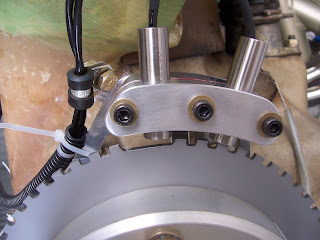Please take a look at these two sorrowful pages of sketches of today's oscilloscope output.
The engine always starts easily and idles very smoothly. Roughness starts around 1,800 RPM. Misfiring is very pronounced, really shakes the engine, and the exhaust is momentarily black.
Page 1.
First wave is pretty much what it looks like with both the 6" and 7 1/2" wheel, at idle. With the 7 1/2" wheel there is a little more of a hump in the middle of the trigger wave. The peak-to-peak amplitude is pretty even and is about 4 volts p-p.
2nd wave. This is what it looks around 2,000 RPM. Notice that the amplitude varies greatly, from about 3 V to 7.5 V p-p. We tried adjusting the air gap from .015 to .060 and didn't see a change here. We thought maybe the variations in amplitude might be from the prop bolts and flange lugs. Just speculation.
3rd wave. Another sketch at high throttle. Here, I tried to include the trigger wave. The trigger wave, at higher RPMs, always had a greater p-p voltage than any other part of the wave, while at idle, the trigger wave was the same.

Page 2.
There always is a consistent phase shift (skipping a tooth?) at any speed. In the sketch, I am attempting to show how it would bounce back and forth. We feel this is a key issue, but have no idea why it is occurring.
We also saw that the amplitude of the wave is pretty even at low RPMs, but at higher revs the amplitude varies a lot. Click on the sketches to better read the voltage ranges.

Other things we tried and noticed:
Changed from 1 1/2" to 6" wheel. no change seen on scope.
Removed the prop bolt closest to the trigger gap. - no change
Tried a smaller diameter sensor. - a little smoother.
Degaussed the crankshaft flange. - no change.
Ran on the single magneto only. - a little smoother.
An automotive timing light flashes consistently at low RPMs, but becomes intermittent, in sync with misfiring, at higher speeds.
Installed the 6" wheel and used the 7-1/2" sensor mount bracket. This caused the sensor to kind of be extended way out from the aluminum bracket. No effect.
I sent these sketches to Tracy Crook, at RWS and he thinks that the change in amplitude is the source of the problem and what I perceived as a "phase shift" is not an issue. Given that, I will be concentrating on eliminating all vibration in the sensor mount bracket.
Sam
 Here is the link to the whole story Trip Across USA It's a pretty long read, so I suggest making yourself comfortable and pouring a cup of coffee first.
Here is the link to the whole story Trip Across USA It's a pretty long read, so I suggest making yourself comfortable and pouring a cup of coffee first.









